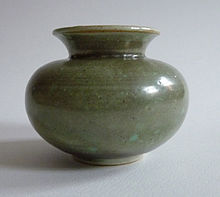Otto Lindig
Otto Lindig (born January 4, 1895 in Pößneck ; † July 4, 1966 in Wiesbaden ) was a German ceramist and sculptor .
Career
Lindig attended the drawing and modeling school in Lichte ( Thuringia ) from 1909 to 1911 and then did an apprenticeship in the Bechstein studio in Ilmenau . In 1913 he entered the ceramics and modeling class of the Grand Ducal School of Applied Arts in Weimar under Henry van de Velde . From 1915 to 1918 he studied sculpture at the Weimar State Academy under Richard Engelmann . In 1919 he received a master's atelier at the arts and crafts school.
Bauhaus Dornburg
In 1920 the State Bauhaus Weimar took over a pottery workshop (Krehan) in the ducal stables of the Rococo castle in Dornburg / Saale, which had been in the family business since 1802 and was to become the workplace of Gerhard Marcks , Max Krehan , Otto Lindig, Marguerite Friedlaender and Theodor Bogler . In 1920 he became an apprentice in the ceramics department and passed the journeyman's examination in 1922 . Together with his brother-in-law Theodor Bogler, he took over the technical management of the Bauhaus pottery as a journeyman. It was the only existing Bauhaus workshop outside of Weimar. But the possibilities for serial production for Lindig and the other artists were very limited. He made designs that were used in the ceramics workshop after 1925 to produce coffee and tea sets and bowls, as well as vases and jugs. The impressively simple design typical of him was very well received, and in 1937 he received the Grand Prix of the Paris World Exhibition for a vase . In 1926 he made the master craftsman examination in Dornburg .
As in 1930 in Thuringia with Wilhelm Frick , the first National Socialist Minister in a German state government came to power and the "Kulturrassist" Paul Schultze-Naumburg was summoned to the director of the Weimar Art School, also the end of the Bauhaus workshop had come. Lindig continued the workshop as a private tenant. It was able to continue its modern design unhindered even under the new rulers. The workshop remained unprofitable, however, and he could not even come close to paying the rent or other payments. In the last year of the war he was drafted into the Wehrmacht , after being prisoner of war he finally gave up the Dornburg workshop on March 31, 1946.
Hamburg
In 1947, on the mediation of his former Dornburg assistant Liebfriede Bernstiel, he followed the call of his former teacher Gerhard Marcks to the State Art School Hamburg (later the University of Fine Arts ). From 1947 to 1960 he was head of the ceramics department there. At times he lived and worked with his partner Liebfriede Bernstiel in Hamburg; In 1952 their daughter Christiane was born. In 1973 works by the artisan-artist were shown in the Kunstgewerbemuseum in Zurich , 1978 in the Kunstgewerbemuseum of the City of Cologne and in 1990 in the Museum of Arts and Crafts in Hamburg. Occasionally ceramic works by the artist can be found in auction shops.
literature
- Hans-Peter Jakobson, Otto Lindig: Otto Lindig - the potter: 1895–1966 . Gera 1990.
- Gisela Reineking-von Bock: Lindig, Otto. In: New German Biography (NDB). Volume 14, Duncker & Humblot, Berlin 1985, ISBN 3-428-00195-8 , p. 603 f. ( Digitized version ).
Web links
- Literature by and about Otto Lindig in the catalog of the German National Library
- Vita Otto Lindig on the daughter's homepage
- Biography at Bauhaus Online
Individual evidence
- ^ Rosalinde Gothe, Jürgen M. Pietsch: Dornburg: From Otto I to Goethe . Edition Akanthus, 2002, ISBN 978-3-00-009673-0
- ↑ The ceramic workshop. (No longer available online.) Bauhaus Archive , Berlin, archived from the original on March 6, 2009 ; Retrieved March 11, 2009 . Info: The archive link was inserted automatically and has not yet been checked. Please check the original and archive link according to the instructions and then remove this notice.
- ↑ Steffen Raßloff: Fritz Sauckel. Hitler's "" Muster-Gauleiter "" and "Sklavenhalter" (publications of the state center for political education Thuringia. Vol. 29). 3rd edition, Erfurt 2008, ISBN 978-3-937967-18-9 (PDF)
- ↑ Hans-Peter Jakobson: Homage Otto Lindig (PDF; 2.9 MB)
- ^ A b Hans-Peter Jakobson: Memories of Liebfriede Bernstiel . Hrsg .: Förderkreis Keramik-Museum Bürgel and Dornburger Keramik-Werkstatt eV Bürgel 2015, p. 19 .
- ↑ Joanna Flawia Figiel, Peter Schmitt: Karlsruher Majolica: A guide through the museum in the majolica , branch museum of the Badische Landesmuseum Karlsruhe, 2004, p 74, ISBN 978-3-88190-368-4
- ↑ Ahrensburg: "Otto Lindis - Ceramics" . In: Die Zeit , No. 39/1976
- ↑ von-Zezschwitz Auctions I ( Memento of the original from June 3, 2015 in the Internet Archive ) Info: The archive link was inserted automatically and has not yet been checked. Please check the original and archive link according to the instructions and then remove this notice.
- ^ Von-Zezschwitz Auctions II
| personal data | |
|---|---|
| SURNAME | Lindig, Otto |
| BRIEF DESCRIPTION | German ceramist and sculptor |
| DATE OF BIRTH | January 4, 1895 |
| PLACE OF BIRTH | Poessneck |
| DATE OF DEATH | 4th July 1966 |
| Place of death | Wiesbaden |
